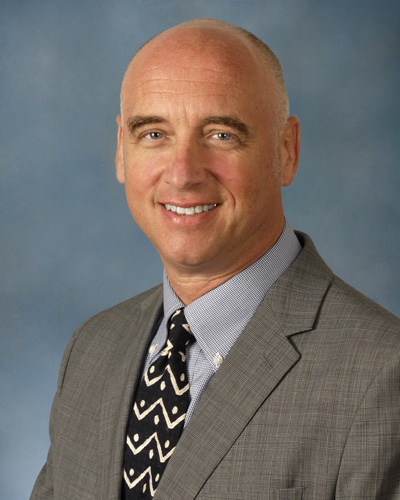November 26, 2018 | Joanne Morrison

Using Light-Sensitive Proteins, Researchers Study the Brain’s Reward Memory Response
In new pre-clinical research, scientists at the University of Maryland School of Medicine (UMSOM), led by Scott Thompson, PhD, Professor of Physiology, have identified changes in brain activity linked to the pleasure and reward system.
The research, published in the journal, Nature, provides news insights into how the brain processes rewards, and advances our understanding of addiction and depression. The research, which was conducted by Tara LeGates, Ph.D., a Research Associate in the Department of Physiology, discovered that the strength of signals between two brain regions, the hippocampus and the nucleus accumbens, is critical for processing information related to a rewarding stimulus, such as its location.
“These two parts of the brain are known to be important in processing rewarding experiences,” said Dr. Thompson.” The communication between these regions is stronger in addiction, although the mechanisms underlying this were unknown. We also suspected that opposite changes in the strength of this communication would occur in depression. A weakening of their connections could explain the defect in reward processing that causes the symptom of anhedonia in depressed patients.” Anhedonia is the inability to enjoy normally pleasurable experiences, such as food, being with friends or family, and sex.
This research uncovered a key circuit in the brain of mice that is important for goal-directed behaviors and shows that the strength of the signals in this circuit are changeable, a process referred to as plasticity. Reward circuits and the molecular components that underlie their plasticity represent new targets for development of treatments for disorders like addiction and depression.
Using Light-Sensitive Proteins
To activate or inhibit this connection, researchers used special light-sensitive proteins introduced into specific neurons in the brains of the mice. In mice with the light-sensitive protein that stimulated the neurons, just four seconds of light exposure not only activated this hippocampus-to-nucleus accumbens pathway while the light was on but persistently reinforced the strength of the signals along this pathway, creating an artificial reward memory.
A day later, the mice returned to the place where the artificial memory was created, even though they never experienced an actual reward there. Researchers then used light to silence the same pathway in mice with the light-sensitive protein that inhibited the neurons and found that this pathway is required for associating a reward with its location. The mice no longer showed a preference for the place where they had interacted with another mouse.
The researchers also examined this circuit in depressed mice. This pathway could not be enhanced using the stimulating light-sensitive protein. After receiving anti-depressant medication, the researchers could enhance this pathway using the light-sensitive protein and create artificial reward memories in the mice.
This work was funded by the National Institutes of Health, the Whitehall Foundation, and the Brain & Behavior Research Foundation (NARSAD Young Investigator Grant).
“These exciting results bring us closer to understanding what goes wrong in the brains of clinically depressed patients,” said UMSOM Dean E. Albert Reece, MD, PhD, MBA, who is also the Executive Vice President for Medical Affairs, University of Maryland, and the John Z. and Akiko K. Bowers Distinguished Professor.
About the University of Maryland School of Medicine
Now in its third century, the University of Maryland School of Medicine was chartered in 1807 as the first public medical school in the United States. It continues today as one of the fastest growing, top-tier biomedical research enterprises in the world -- with 43 academic departments, centers, institutes, and programs; and a faculty of more than 3,000 physicians, scientists, and allied health professionals, including members of the National Academy of Medicine and the National Academy of Sciences, and a distinguished recipient of the Albert E. Lasker Award in Medical Research. With an operating budget of more than $1 billion, the School of Medicine works closely in partnership with the University of Maryland Medical Center and Medical System to provide research-intensive, academic and clinically-based care for more than 1.2 million patients each year. The School has over 2,500 students, residents, and fellows, and more than $530 million in extramural funding, with most of its academic departments highly ranked among all medical schools in the nation in research funding. As one of the seven professional schools that make up the University of Maryland, Baltimore campus, the School of Medicine has a total workforce of nearly 7,000 individuals. The combined School and Medical System (“University of Maryland Medicine”) has an annual budget of nearly $6 billion and an economic impact more than $15 billion on the state and local community. The School of Medicine faculty, which ranks as the 8th highest among public medical schools in research productivity, is an innovator in translational medicine, with 600 active patents and 24 start-up companies. The School works locally, nationally, and globally, with research and treatment facilities in 36 countries around the world. Visit medschool.umaryland.edu/
Contact
Department of Anesthesiology
(410) 328-6120 (phone)
(410) 328-5531 (fax)
newsletter@som.umaryland.edu
Office of Public Affairs
655 West Baltimore Street
Bressler Research Building 14-002
Baltimore, Maryland 21201-1559
Contact Media Relations
Joanne Morrison
(202) 841-3369 jmorrison@som.umaryland.edu
